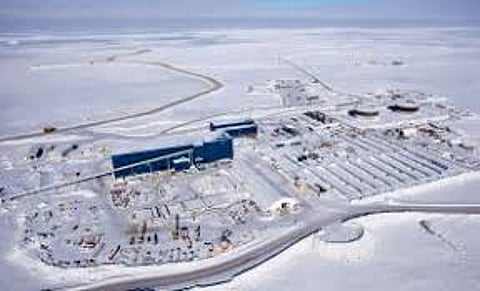

Most notably, the attributed average value per carat has increased to US$140 per carat; a 25% increase from the 2017 average values of US$112 per carat. This figure is derived from applying a base case value distribution model to models of recoverable (+1 mm) diamond size frequency distribution for each geological domain. The increase from the reported 2017 average diamond value reflects revised size frequency distribution models and a revised value distribution model for the Faraday 2 kimberlite. Some rounding error may occur in the values reported.
The updated resource was determined by Aurora Geosciences Ltd. and SRK Consulting Inc., who were engaged by the Company to conduct the exercise.
President and Chief Executive Officer for Mountain Province Stuart Brown commented: "The Faraday 2 project is one of three known kimberlites within our wholly owned exploration properties adjacent to the Gahcho Kué Mine. As anticipated from our microdiamond results reported earlier this year, the inclusion of the northwest extension at Faraday 2 has greatly increased the value of this resource and at an average diamond value of US$140 per carat offers significant potential. We are very pleased with the results of this exploration program and view this as a positive step towards potentially extending our operations beyond the existing mine plan at Gahcho Kué."
Faraday 2 Updated Inferred Resource
The Faraday 2, Faraday 1-3, and Kelvin kimberlites are located approximately 10 kilometers northeast of the Gahcho Kué Mine. The Faraday 2 kimberlite is an irregularly shaped, inclined pipe-like body that has been drill delineated for over 600 meters and remains open to the northwest. The body varies in width between 30-50 meters and the vertical thickness ranges between 10-100 meters in subcrop at the southeast end beneath Faraday Lake, to about 50 meters thick at the furthest end of the northwest extension.
The full scope of the 2019 mineral resource update for Faraday 2 has incorporated the following components:
The geological model for Faraday 2 is based on drilling and bulk density data acquired to the end of 2018 that includes the northwest extension. The database is comprised of 22,183 meters of core drilling from 102 drill holes and 3,688 meters of large diameter drilling from 31 RC drill holes. A total of 811 bulk density measurements were derived from drill core within Faraday 2, of which 250 are located within northwest extension. A total of 6.42 tonnes of core was processed for microdiamonds, and 726.47 carats of +1 DTC sieve diamonds contained in 275.38 tonnes of kimberlite recovered by large diameter drilling were used for grade and value determinations. The 2017 valuation of the +1DTC diamonds was updated by WWW International according to their February 2019 price book. An adjusted value distribution model was applied against the modeled size frequency distribution curves for each geological domain to derive a weighted average US$ per carat estimate for the Faraday 2 kimberlite. Due to the small quantity of carats available for grade and valuation estimates there is a high degree of uncertainty in these estimates; additional bulk sampling of Faraday 2 would increase the confidence in the diamond grade and value estimates.
SRK Consulting Inc. (Vancouver, B.C.) provided guidance on the evaluation program at Faraday 2 and recently completed a comprehensive review of geological, microdiamond, bulk sampling, and valuation results in order to estimate an Inferred Mineral Resource for the Faraday 2 kimberlite, as provided in the table below.
Inferred Mineral Resource Estimate for the Faraday 2 Kimberlite (effective date of February 28, 2019)
Kimberlite | Tonnes (million tonnes) | Grade2 (carats per tonne) | Carats (million carats) | Value (US$ per carat) | Faraday 2 (2019) | 2.071 | 2.63 | 5.45 | $1403 | Faraday 2 (2017) | 1.39 | 2.24 | 3.13 | $112 | Variance % | +49% | +17% | +74% | +25% |
The NI 43-101 Standards and Canadian Institute of Mining and Metallurgy guidelines for Mineral Resources and Mineral Reserves stipulate that a Mineral Resource needs to have a "reasonable prospect of economic extraction of the specified ore". SRK concluded that the Faraday 2 kimberlite has reasonable prospects for eventual economic extraction. Inferred Mineral Resources are considered too speculative geologically to have the economic considerations applied to them that would enable them to be categorized as Mineral Reserves. Mineral Resources are not Mineral Reserves and do not have demonstrated economic viability.
Follow DiamondWorld on Instagram: @diamondworldnet
Follow DiamondWorld on Twitter: @diamondworldnet
Follow DiamondWorld on Facebook: @diamondworldnet
1) | The estimate includes the entire Faraday 2 kimberlite as defined by the current geological model, extending from the base of | 2) | Grade is expressed as recoverable diamonds above 1 mm bottom cut-off | 3) | Average value is derived by applying a base case value distribution model to models of recoverable (+1 mm) diamond size |
